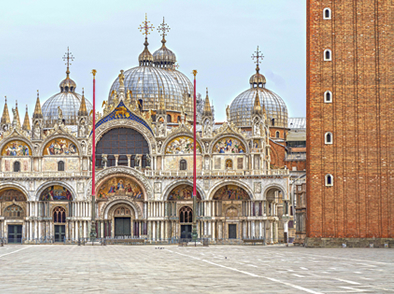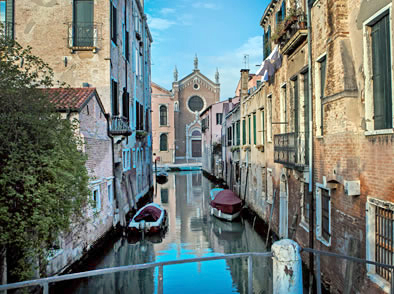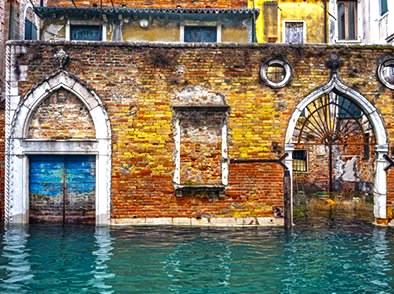Venice Quarantine Islands: Lazzaretto Nuovo
The plague was for centuries by far the worst possible disaster, the speed of diffusion and virulence will kill thousands in a very short time and in vast areas erasing thus whole communities. It was considered as God’s wrath against sinful mankind and you could just pray the Lord and Mary and seek for one of the medical saints help so to be saved. Two huge churches were built in the city as thanksgivings for the end of the disease in 1576 and 1631, the Redentore and La Salute.
Venice potentially was an easy target for the plague since she was a port of call and transit for all maritime routes from Europe to the East a true hub welcoming ships and people from all over. Well aware of her condition Venice developed a modern system of prevention creating quarantine areas on a few islands far from the city, the Lazzaretti very much imitated by other Italian cities.
Venice’s first Health Office was established in 1486 in San Marco in a building located in the area of the present Public Gardens. Among its many duties, the new office had to check all the goods and passengers of any ship arrivals and prevent their disembarking before the sanitary exam was performed. The Health Office officers used the top of San Marco bell tower as an observation point from where they could record all newcomers arriving by ship in the lagoon and call the Sanitary patrol to approach each vessel and detour it to the decontamination areas located in the Lazzaretti islands. In the 17th century armed boats patrolled the lagoon in their attempt to deter any ship downloading goods before the vessel’s officers were debriefed on their journey. They also had to show a travel record reporting the ports where they had stopped and declaring whether they were coming from infected places or not. After these procedures the ship and all its contents, human beings and freight, were directed to a Lazaretto island where they had to spend a quarantine time.
The first Lazzaretto, known as the vecchio, was set up in 1423 during an outburst of plague. The island where it was established was called Santa Maria di Nazareth, a word changed to Nazaretum first and Lazzaretum at the end.
Lazzaretto became then the term identifying sanitary quarantine and treatment areas related to the plague European wide.. All cases of plague had to be treated in that island including decontamination and medical care run by doctors and nurses paid by the State. It wasn’t easy to oblige suspected and known infected people to stay in the Lazzarettos. Among other measures, the government had to force awareness of the isolation practices by emulating the cult of san Rocco, who voluntarily abandoned his community and choose to die in loneliness anticipating the time when he would get sick.
In 1468 the opening of a new lazaretto for suspected cases of plague brought to attention different stages in the infection itself and the risk of its diffusion. The old one was continued to be used sometimes for regular quarantines well into the 18th century, it could host up to 294 people and tons of merchandise. In 1852 it became a military facility to be abandoned in the last decades and now waits to be restored.
The old lazaretto set the name and the model for all other similar places in the Mediterranean.
As one place proved not to be enough to satisfy an effective sanitary policy once the difference between treatment and prevention was clear, in 1468 the Venetian Senate established the construction of a New Lazzaretto on the ‘vigna murata’ island. It was a place for anyone that after being cured from the plague had to spend his recovery time in isolation, and for all those who arrived from areas reputed to be infected to spend their quarantine. The difference between old and new lazaretto was that the first was set up as a hospital while the second was a place of decontamination with warehouses to store the merchandise and living quarters for people. The vast majority and the and freight came through the Mediterranean sea routes, thus transforming the detention time in the lazaretto into a travel experience for most of the merchant European society of the time. Once there all the goods had to be kept in large warehouses and once out of their containers they had to be exposed to aereation with the purpose of eliminating the plague’s miasmas considered as the main vehicle of its diffusion.
For air decontamination a mixture of aromatic herbs were burnt like juniper and rosemary. Different goods needed different treatments: silk, wool, cotton and leather had to be put several times a day in open air, clothes were boiled, feathers were strewn with vinegar. Livestock was also put into the island premises while human beings had to live in rows of small single room blocks each one with its fireplace whose chimneys were located along the perimeter walls , looked like a continuous crenellation when seen from afar.
During the devastating plague of 1576 a vast attempt to restrict its massive spread was led by marooning in the lagoon thousands of boats where tens of thousands people spent their insulation term. The water was patrolled by armed boats to prevent any quarantine break and the gallows were threatened as a harsh punishment for offenders.
From the late 16th to early 17th centuries the Lazzaretto nuovo was completely restructured. The new facility had 200 rooms for people and new warehouses for storage while using all shelters it could to host up to 4000 people and 200 horses.
During the 18th century the place fell into decay not just for lack of mainteanance but because of the turning into a swamp of the canals around the island. The final closure foresaw the opening of the Lazzaretto Nuovissimo during the Republic’s last years on the island of Poveglia.
During the 19th by modifying the warehouses a large remodeling transformed the place into a military stronghold where gun powder turrets had been since the 16th century when the handling of this dangerous product required its storage far from inhabited areas; two are still part of the present Lazzaretto.
It was in total abandonment and decay up to the eighties when the combined efforts of the Archeo Club Italia and the Italian Office for preserving the national heritage thoroughly restored all the building in the island making the place very enjoyable nowadays. Large grassy areas surround the buildings while many trees grow on the ground all in a walled space overlooking the entire lagoon. You can walk all around the walls through a path meters away from mud formations and meandering canals, the closest you can get to the natural environment of the lagoon. The approach by boat to the lazaretto island is also very pleasant, passing nearby the agricultural island of Le Vignole and getting very close to San Erasmo.
Inside the largest warehouse or Tezon Grande you can visit its content such as fishing lagoon boats, a collection of old anchors and many more items found by the Archeo Club during several diggings. The viewers’ attention will also be drawn by hand drawn bill boards where porters classified all data about each ship’s load like vessels’ name, provenance, kind of good, quantity, date of arrival and number of days, giving a true glimpse into the merchant Mediterranean routes of the past.
All in all, an important and truly pleasant place to spend a couple of hours in a beautiful environmental setting discovering this little known part of Venice’s past!
Ask A Guide in Venice for a private tour to Lazzaretto Nuovo
Get in touch!
Which Venice will you discover?
INTRODUCTORY TOURS
These tours are intended for first time visitors who wish to become acquainted with Venice’s main sights and landmarks, gaining an overall picture of its history and modern-day life.
IN DEPTH TOURS
Art, in all forms has been a unique ingredient of Venice’s success. Discover the magnificence of the grand Venetian architects and painters. For the ones that live in the now the contemporary art, contemporary architecture and the truly authentic glass studios where masters are at work.
UNUSUAL TOURS
These tours are intended for visitors who wish to experience areas and sites rarely seen by tourists, in both urban locations and beyond. Take this opportunity to discover truly authentic art studios, furnaces and lagoon islands with us.




